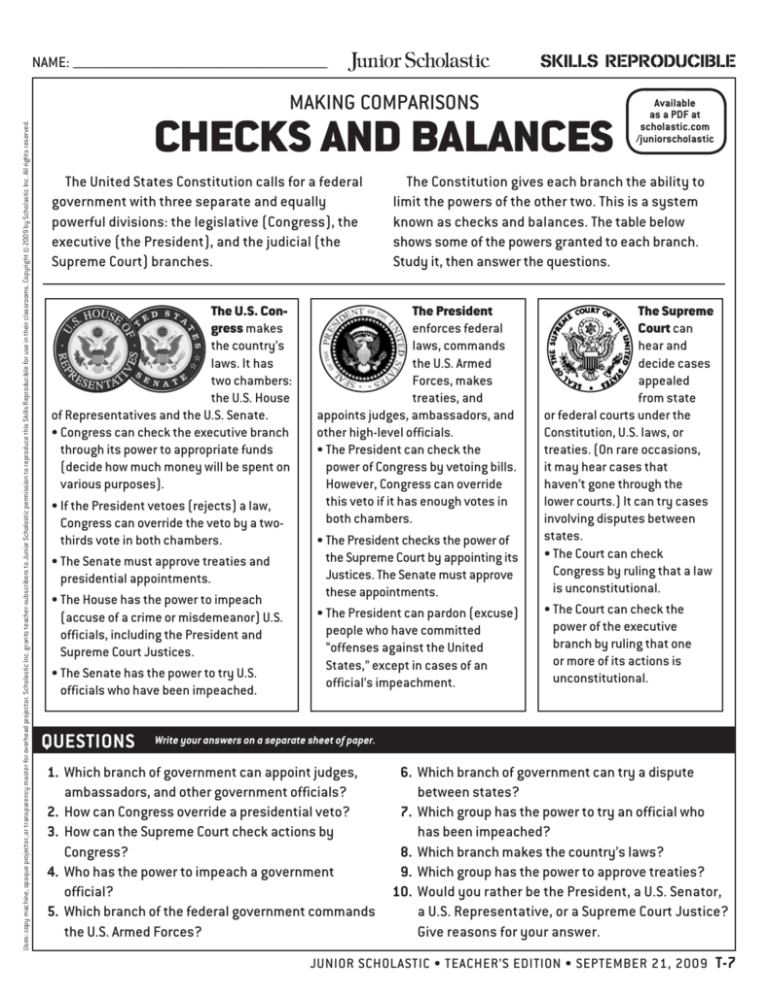
NAME: __________________________________________________________________________________________________________________________
®
Uses: copy machine, opaque projector, or transparency master for overhead projector. Scholastic Inc. grants teacher-subscribers to Junior Scholastic permission to reproduce this Skills Reproducible for use in their classrooms. Copyright © 2009 by Scholastic Inc. All rights reserved.
Making Comparisons
skills reproducible
Checks And Balances
The United States Constitution calls for a federal
government with three separate and equally
powerful divisions: the legislative (Congress), the
executive (the President), and the judicial (the
Supreme Court) branches.
The ­U.S. Congress makes
the country’s
laws. It has
two chambers:
the U.S. House
of Representatives and the U.S. Senate.
• Congress can check the executive branch
through its power to appro­priate funds
(decide how much money will be spent on
various purposes).
• If the President vetoes (rejects) a law,
Congress can override the veto by a twothirds vote in both chambers.
• The Senate must approve treaties and
presidential appointments.
• The House has the power to impeach
(accuse of a crime or misdemeanor) U.S.
officials, including the President and
Supreme Court Justices.
• The Senate has the power to try U.S.
officials who have been impeached.
questions
Available
as a PDF at
scholastic.com
/juniorscholastic
The Constitution gives each branch the ability to
limit the powers of the other two. This is a system
known as checks and balances. The table below
shows some of the powers granted to each branch.
Study it, then answer the questions.
The President
enforces federal
laws, commands
the U.S. Armed
Forces, makes
treaties, and
appoints judges, ambassadors, and
other high-level officials.
• The President can check the
power of Congress by vetoing bills.
However, Congress can override
this veto if it has enough votes in
both chambers.
• The President checks the power of
the Supreme Court by appointing its
Justices. The Senate must approve
these appointments.
• The President can pardon (excuse)
people who have committed
“offenses against the United
States,” except in cases of an
official’s impeachment.
The Supreme
Court can
hear and
decide cases
appealed
from state
or federal courts under the
Constitution, U.S. laws, or
treaties. (On rare occasions,
it may hear cases that
haven’t gone through the
lower courts.) It can try cases
involving disputes between
states.
• The Court can check
Congress by ruling that a law
is unconstitutional.
• The Court can check the
power of the executive
branch by ruling that one
or more of its actions is
unconstitutional.
Write your answers on a separate sheet of paper.
1. Which branch of government can appoint judges,
ambassadors, and other government officials?
2. How can Congress override a presidential veto?
3. How can the Supreme Court check actions by
­Congress?
4. Who has the power to impeach a government
official?
5. Which branch of the federal government commands
the U.S. Armed Forces?
6. Which branch of government can try a dispute
between states?
7. Which group has the power to try an official who
has been impeached?
8. Which branch makes the country’s laws?
9. Which group has the power to approve treaties?
10. Would you rather be the President, a U.S. Senator,
a U.S. Representative, or a Supreme Court Justice?
Give reasons for your answer.
JUNIOR SCHOLASTIC • Teacher’s Edition • September 21, 2009 T-7









